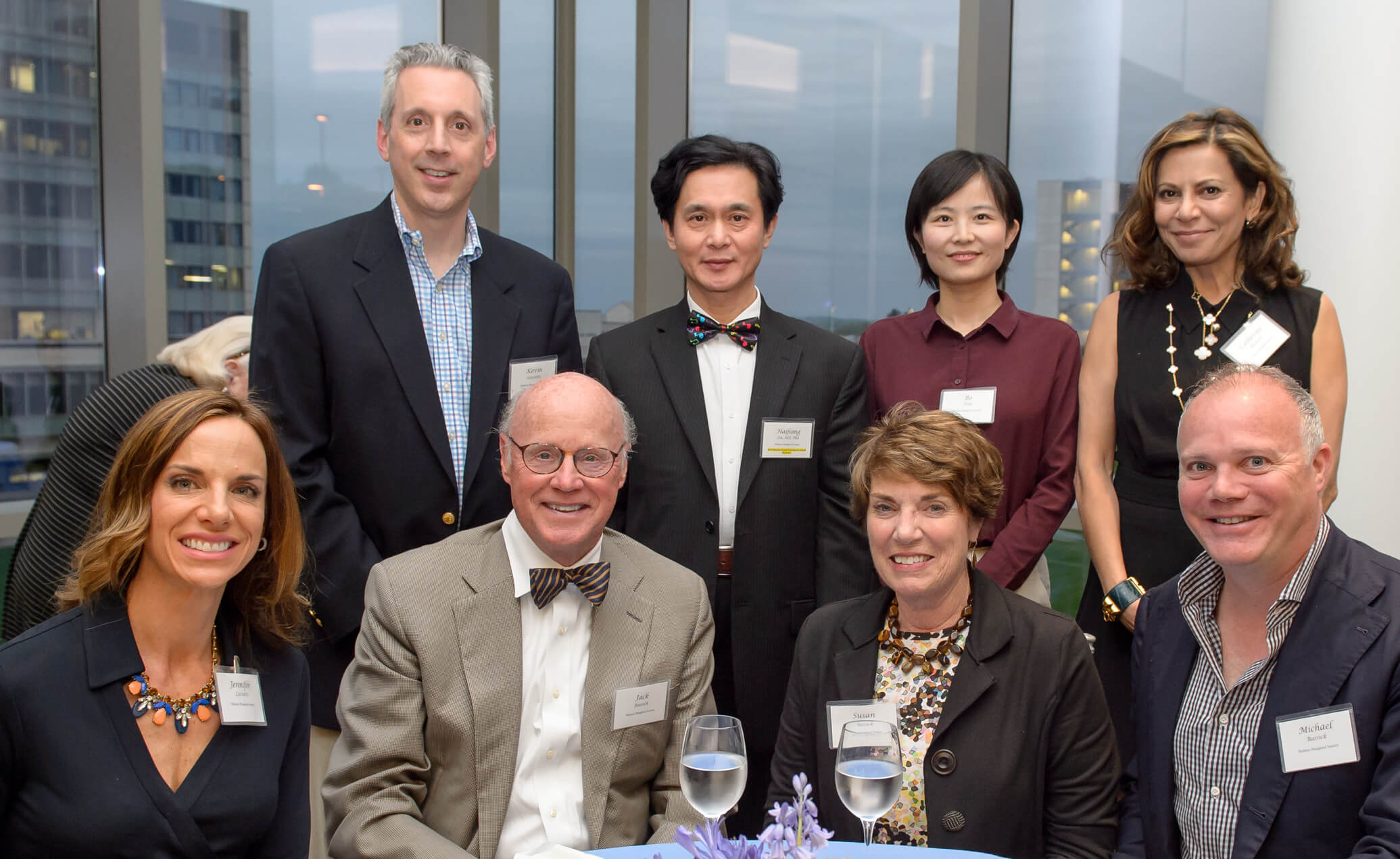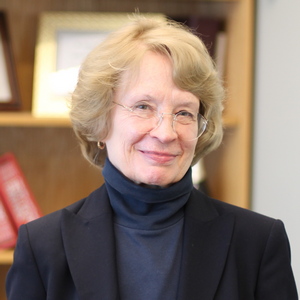Bassick Family Foundation boosts COVID-19 research at UMass Chan Medical School
June 23, 2020

Front row, from left: Jennifer Bassick Lisciotti, Jack Bassick, Susan Bassick
and Michael Bassick. Top row, from left: Kevin Lisciotti, Haijian Lin, MD, PhD,
Bo Tian, MD, PhD and Catherine Bassick.
As the COVID-19 pandemic rocketed around the world, John “Jack” Bassick didn’t hesitate to act.
“Given the catastrophic global nature of the threat, I thought this was a once-in-a-lifetime opportunity to help solve a major, worldwide human health problem—and my family agreed,” Mr. Bassick said.
The Bassick Family Foundation has supported early-stage biomedical research at UMass Chan Medical School for many years through annual gifts to the Hudson Hoagland Society (HHS), which funds Worcester Foundation seed grants. This year, the Bassicks decided to make an additional major gift to the newly established COVID-19/Pandemic Research Fund, which supports more than 19 labs at UMMS working on therapies, vaccines and diagnostics in the fight against COVID-19.
“I expected that UMass Chan Medical School would quickly bring to bear its considerable biomedical research resources to help solve this, hopefully, major human health problem,” Mr. Bassick said.
Mr. Bassick is the former executive vice president and director of research and development at the David Clark Company in Worcester. He joined the company in 1965, after serving four years in the U.S. Air Force as an aerospace physiological training specialist. At David Clark Co., Mr. Bassick worked on the design and development of several advanced air and space crew protective technologies, including pressure suits worn by generations of NASA astronauts. He retired from David Clark Co. in 2011.
Several years ago, the worlds of outer and inner space intersected for Mr. Bassick when he learned that NASA astronaut Story Musgrave was going to speak at a Hudson Hoagland Society meeting at the former Worcester Foundation for Biomedical Research (WFBR). Jack joined HHS, attended the meeting and was captivated by the experience.
“I realized that I have an inherent natural interest in the life sciences,” he said. “I learned about the world-class biomedical research going on right here in Worcester, and I thought working with the Worcester Foundation provided a perfect opportunity to think globally and act locally.”
Mr. Bassick became a member of the HHS executive committee and served as a WFBR trustee for several years prior to its merger with UMass Chan Medical School in 1997. He and his wife Susan eventually enlisted their children, Michael, Matthew and Jennifer, in their philanthropic efforts. All five are trustees of the Bassick Family Foundation.

Trudy Morrison, PhD, professor of microbiology & physiological systems at UMMS, who is a leader in virus research, was named recipient of the 2020 Bassick Family Foundation award at the HHS annual meeting in May 2020 for her work examining how certain viruses latch on to host cells and cause infection.
For the past several years, Dr. Morrison and her team have been working on a potential vaccine for respiratory syncytial virus (RSV), which causes severe lower respiratory tract disease in young children and the elderly. When the COVID-19 pandemic emerged this year, Dr. Morrison immediately knew the technology platform developed for the RSV project could be applied to this coronavirus.
The disease COVID-19 is caused by the Severe Acute Respiratory Syndrome Coronavirus 2 (SARS-CoV-2). Like RSV, SARS-CoV-2 is classified as an “enveloped virus,” because its genes are inside an envelope composed of a lipid membrane and virus-encoded glycoproteins inserted in that membrane.
A virus cannot reproduce on its own. First, it must infect a host cell. Then, the viral genes are released into the cell and hijack that cell’s machinery to make more copies of itself. Those new copies break out of the host cell and either travel through the body to infect more cells or shed from an infected person, transmitting infections to other people. It is the envelope-associated proteins that initiate those infections.
The analogy of an envelope, like one might use to mail a letter, is helpful to understand Dr. Morrison’s approach. Postal envelopes come in standard sizes and can be used to send a variety of contents. An address on the outside of the envelope determines its destination. In the same way, different viruses can have similar envelopes. The distinction comes with the envelope-associated proteins that provide the address, directing the virus to specific cells that can support an infection.
Dr. Morrison has developed a method to create a virus envelope with associated proteins that provide the address—one that looks like a real virus, but without any genes inside. That construct is called a virus-like particle (VLP).
For the RSV project, Dr. Morrison’s team engineered a VLP containing the surface proteins that RSV uses to infect cells. Pre-clinical testing has shown that this VLP works like a vaccine, generating protective immune responses in an animal model.
For SARS-CoV-2, the key factor on the surface of the envelope that facilitates infection is called the S (spike) protein. What Dr. Morrison hopes to do is create a VLP with the S protein on the outside of the envelope that prompts the immune system to respond. And since there are no genes within the envelope, the VLP vaccine can never cause COVID-19.
“The first thing we have to do is really the hardest, to engineer the form of the surface protein that can assemble into VLPs and elicit protective immune responses,” Dr. Morrison said.
The Morrison lab was able to begin this vital work because of the Bassicks recent contributions.
“We had no funding to work on COVID-19, and now we are now off and running because of the Bassick Family Foundation’s generous support,” she said. “We are extremely grateful.”
Dr. Morrison hopes to have VLPs developed against the SARS-CoV-2 ready for pre-clinical testing sometime in late 2020.
